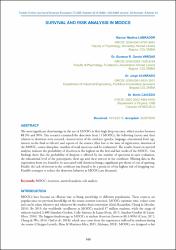Survival and risk analysis in MOOCS

Göster/Aç
Erişim
info:eu-repo/semantics/openAccessAttribution-NonCommercial 3.0 United Stateshttp://creativecommons.org/licenses/by-nc/3.0/us/Tarih
2019Üst veri
Tüm öğe kaydını gösterKünye
Labrador, M. M., Vargas, G. R. G., Alvarado, J., Caicedo, M. (2019).Survival and risk analysis in MOOCS. TOJDE, 20 (4), 149-159.Özet
The most significant disadvantage in the use of MOOCs is their high drop out rates, which reaches between
88.3% and 90%. This research examined the desertion from 15 MOOCs, the following factors and their
relation to desertion were assessed, characteristics of the students (gender, language, educational level, age,
interest in the final certificate) and aspects of the courses (data lost at the time of registration, duration of
the MOOC, course discipline, number of total questions and by evaluation). The results, based on survival
analysis, indicate the probability of desertion is the highest on the first and last weeks of the MOOC. Our
findings show that the probability of dropout is affected by the number of questions in each evaluation,
the educational level of the participants, their age and their interest in the certificate. Missing data in the
registration form was found to be associated with desertion being a significant pre-dictor of risk of quitting.
Finally, the lack of interest in the certificate was found to be a predictor of the highest risk of dropping out.
Possible strategies to reduce the desertion behavior at MOOCs are discussed.
Kaynak
Turkish Online Journal of Distance Education-TOJDECilt
20Sayı
4Bağlantı
https://hdl.handle.net/11421/23040Koleksiyonlar
Aşağıdaki lisans dosyası bu öğe ile ilişkilidir:


















